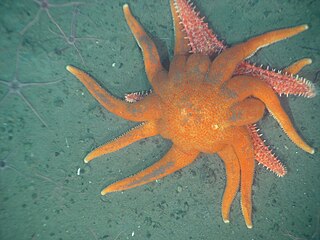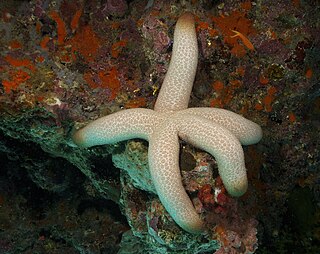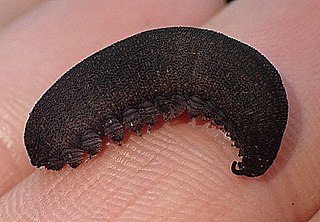
An echinoderm is any deuterostomal animal of the phylum Echinodermata, which includes starfish, brittle stars, sea urchins, sand dollars and sea cucumbers, as well as the sessile sea lilies or "stone lilies". While bilaterally symmetrical as larvae, as adults echinoderms are recognisable by their usually five-pointed radial symmetry, and are found on the sea bed at every ocean depth from the intertidal zone to the abyssal zone. The phylum contains about 7,600 living species, making it the second-largest group of deuterostomes after the chordates, as well as the largest marine-only phylum. The first definitive echinoderms appeared near the start of the Cambrian.

Starfish or sea stars are star-shaped echinoderms belonging to the class Asteroidea. Common usage frequently finds these names being also applied to ophiuroids, which are correctly referred to as brittle stars or basket stars. Starfish are also known as asteroids due to being in the class Asteroidea. About 1,900 species of starfish live on the seabed in all the world's oceans, from warm, tropical zones to frigid, polar regions. They are found from the intertidal zone down to abyssal depths, at 6,000 m (20,000 ft) below the surface.

The crown-of-thorns starfish, Acanthaster planci, is a large starfish that preys upon hard, or stony, coral polyps (Scleractinia). The crown-of-thorns starfish receives its name from venomous thorn-like spines that cover its upper surface, resembling the biblical crown of thorns. It is one of the largest starfish in the world.

Tube feet are small active tubular projections on the oral face of an echinoderm, such as the arms of a starfish, or the undersides of sea urchins, sand dollars and sea cucumbers; they are more discreet though present on brittle stars, and have only a feeding function in feather stars. They are part of the water vascular system.

The Valvatida are an order of starfish in the class Asteroidea, which contains 695 species in 172 genera in 17 families.

Peripatopsis is a genus of velvet worms in the Peripatopsidae family. These velvet worms are found in the KwaZulu-Natal, Western Cape, and Eastern Cape provinces of South Africa. This genus was proposed by the British zoologist Reginald I. Pocock in 1894 with Peripatopsis capensis designated as the type species.

Limacia clavigera, sometimes known by the common name orange-clubbed sea slug, is a sea slug, a species of dorid nudibranch. It is a marine gastropod mollusc in the family Polyceridae.

Culcita schmideliana, commonly known as the spiny cushion star, is a species of pin-cushion star. It has a variety of base colors and often patches of a different color. It is pentagonal in shape and lives in the tropical Indo-Pacific. This species is rarely kept by hobby aquarists.

Reishia clavigera is a species of sea snail, a marine gastropod mollusc in the family Muricidae, the murex snails or rock snails.

Caño Cristales is a Colombian river located in the Serranía de la Macarena, an isolated mountain range in the Meta Department. It is a tributary of the Guayabero River, itself a part of the Orinoco basin. Caño Cristales was found in 1969 by a group of cattle farmers. The river is commonly called the "River of Five Colors" or the "Liquid Rainbow," and is noted for its striking colors. The bed of the river from the end of July through November is variously colored yellow, green, blue, black, and especially red, the last caused by Rhyncholacis clavigera plants on the riverbed. In recent years, the river has become a tourist destination; there were more than 16,000 visitors in 2016.

The Mithrodiidae is a family of starfish in the order Valvatida.

The Mithrodia is a genus of starfish in the family Mithrodiidae.

Peripatopsis clavigera, the Knysna velvet worm, is a species of velvet worm in the Peripatopsidae family. This species has 16 pairs of legs and ranges from 4 mm to 17 mm in length. Peripatopsis clavigera is found in subtropical or tropical moist montane forests of the Diepwalle Nature Reserve in South Africa.

Mithrodia bradleyi, known as Bradley's sea star, is a species of sea star. It was first described to science by Addison Emory Verrill in 1870. It was named after Frank Howe Bradley, who collected, in Panama, the type specimen described by Verrill.
Thromidia seychellesensis is a species of starfish in the family Mithrodiidae. It occurs in Seychelles, Indian Ocean.
Peripatopsis edenensis is a species of velvet worm in the family Peripatopsidae. This species is a clade in the P. clavigera species complex. This species has 16 pairs of legs, varies from slate black to charcoal, and ranges from 4 mm to 17 mm in length. Also known as the Eden velvet worm, this species is found in the Garden of Eden Nature Reserve and in forests along the coast of Western Cape province in South Africa.
Peripatopsis ferox is a species of velvet worm in the family Peripatopsidae. This species is a clade in the P. clavigera species complex. This species has 17 pairs of legs, varies from slate black to brown, and ranges from 17 mm to 28 mm in length. Also known as the Wilderness velvet worm, this species has an extensive distribution across many patches of forest in Western Cape province in South Africa.
Peripatopsis mellaria is a species of velvet worm in the family Peripatopsidae. This species is a clade in the P. clavigera species complex. This species has 17 pairs of legs, varies from slate black to charcoal, and ranges from 11 mm to 20 mm in length. Also known as the Outeniqua velvet worm, this species is found in forests along the coast in Western Cape province in South Africa.
Peripatopsis mira is a species of velvet worm in the family Peripatopsidae. This species is a clade in the P. clavigera species complex. This species has 17 pairs of legs, varies from slate black to charcoal, and is found on the south-facing slope of the Outeniqua mountain range in Western Cape province in South Africa.
Peripatopsis tulbaghensis is a species of velvet worm in the family Peripatopsidae. This species is dark brown with 17 pairs of legs and ranges from 8 mm to 32 mm in length. Also known as the Tulbagh velvet worm, this species is found in Groot Winterhoek mountain region in South Africa.















